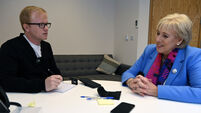Number of adults taking up education courses doubles in five years

the percentage of adults participating in learning activities in 2019 stood at 12.6%, up from 6.5% in 2015.
The number of people taking up apprenticeships, and the number of adults taking up adult learning courses has doubled in the last five years, new figures show.
There has been a marginal decrease in the average class size in primary school, from 24.3 to 24.1 pupils, and there has been a slight decrease in the pupil-teacher ratio in both first and second level education, according to figures in the new Education Indicators 2020 report.
And with the report showing a steady rise in the number of part-time and remote learning students pre-Covid, the Minister for Higher Education, Simon Harris, said he hopes the system can retain flexibility to facilitate more remote learning in the future.
The report is being published today by Minister for Education Norma Foley and Minister for Further and Higher Education, Research, Innovation and Science, Simon Harris.
It presents a snapshot of the education system as a whole at a single point in time but it also charts its progress over the past five years.
Its key findings show:
- as of this academic year, there were 567,716 children in primary school and a further 371,450 in secondary school, being taught by 66,932 teachers;
- the average pupils per teacher in primary school stood at 15, down from 15.2 in 2019, while in secondary school it was 12.8, down from 13;
- the number of children in special classes in mainstream primary schools continues to rise - from 4,355 in 2015 to 6,822 in 2019 - with 13,530 special education teachers and 15,799 SNAs;
- the number of multi-denominational primary schools has risen from 120 five years ago to 153.
In the further and higher education sector, the report found there were 211,274 graduates across all levels of the National Framework of Qualifications (NFQ) levels in 2018, with just over 69,700 graduates receiving an award at Honours Degree level (NFQ Level 8) or higher in 2018, while the number of part-time and remote students is rising steadily with part-time rising from 37,000 in 2015 to 43,000 in 2018.
The number of students studying on a part-time or flexible basis, including remote learning, has increased from 48,068 in 2017 to 52,236 in 2018.
The number of people taking up apprenticeships is rising strongly, up from 8,317 in 2015 to 17,829 in 2019, while the total number of post-graduate researchers has risen from 9,773 in 2015 to 10,065 in 2018 and women account for just over half of full-time PhD students.
The report also shows that just under 18,000 people aged 55 and over achieved an award on the NFQ in 2018 while the percentage of adults participating in learning activities in 2019 stood at 12.6%, up from 6.5% in 2015.
Minister Harris welcomed the news that the percentage of adults participating in learning activities has almost doubled in five years.
“I am also very pleased to say that the number of people taking up apprenticeships is rising strongly, more than doubling in that five year period,” he said.
“We have seen a big jump in the number of people studying in a part-time or flexible way, including remote learning, and this was before the pandemic struck.
“I hope that we will retain this flexibility into the future, allowing people to learn in the right place for them and at the right time.”









